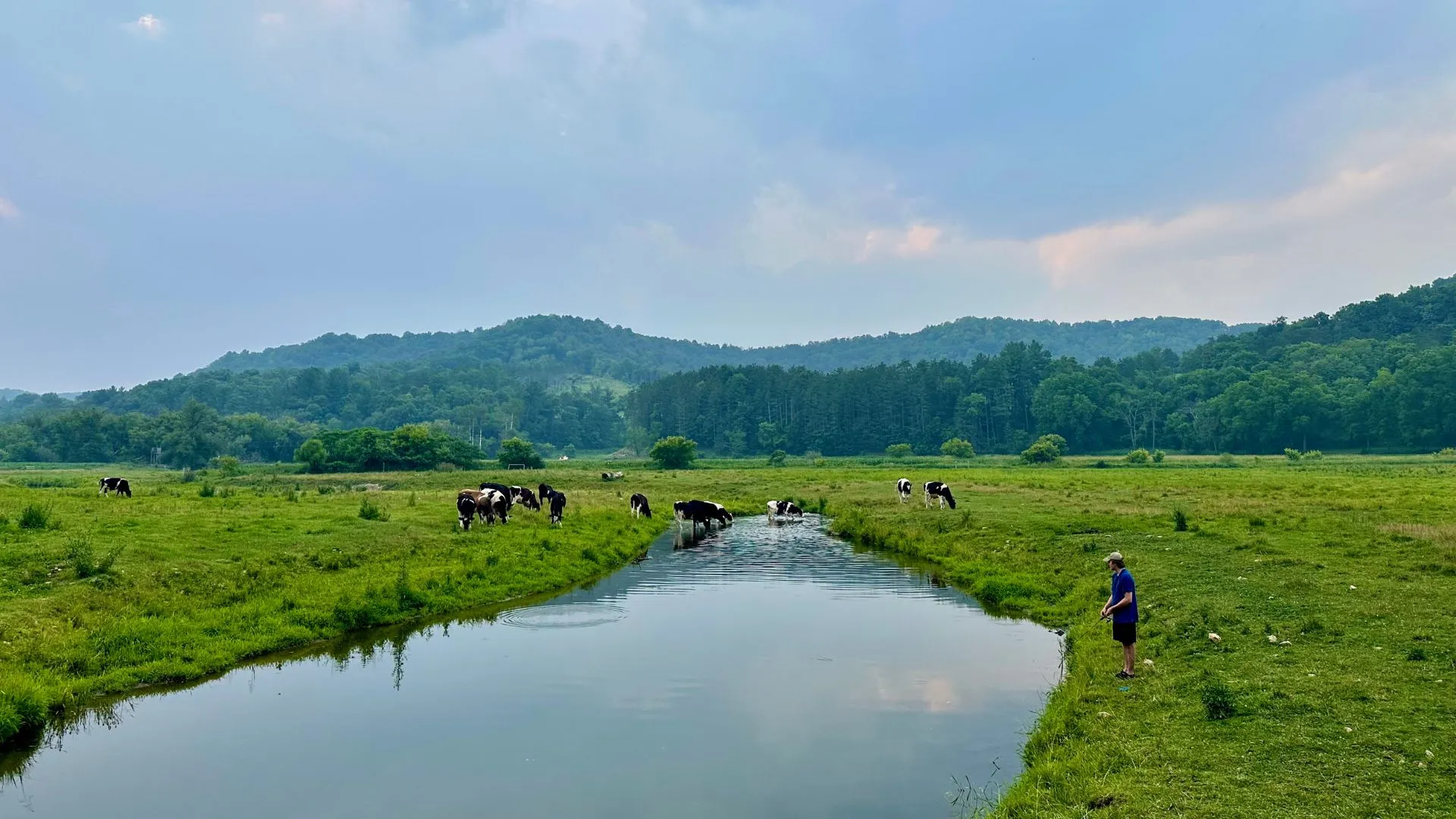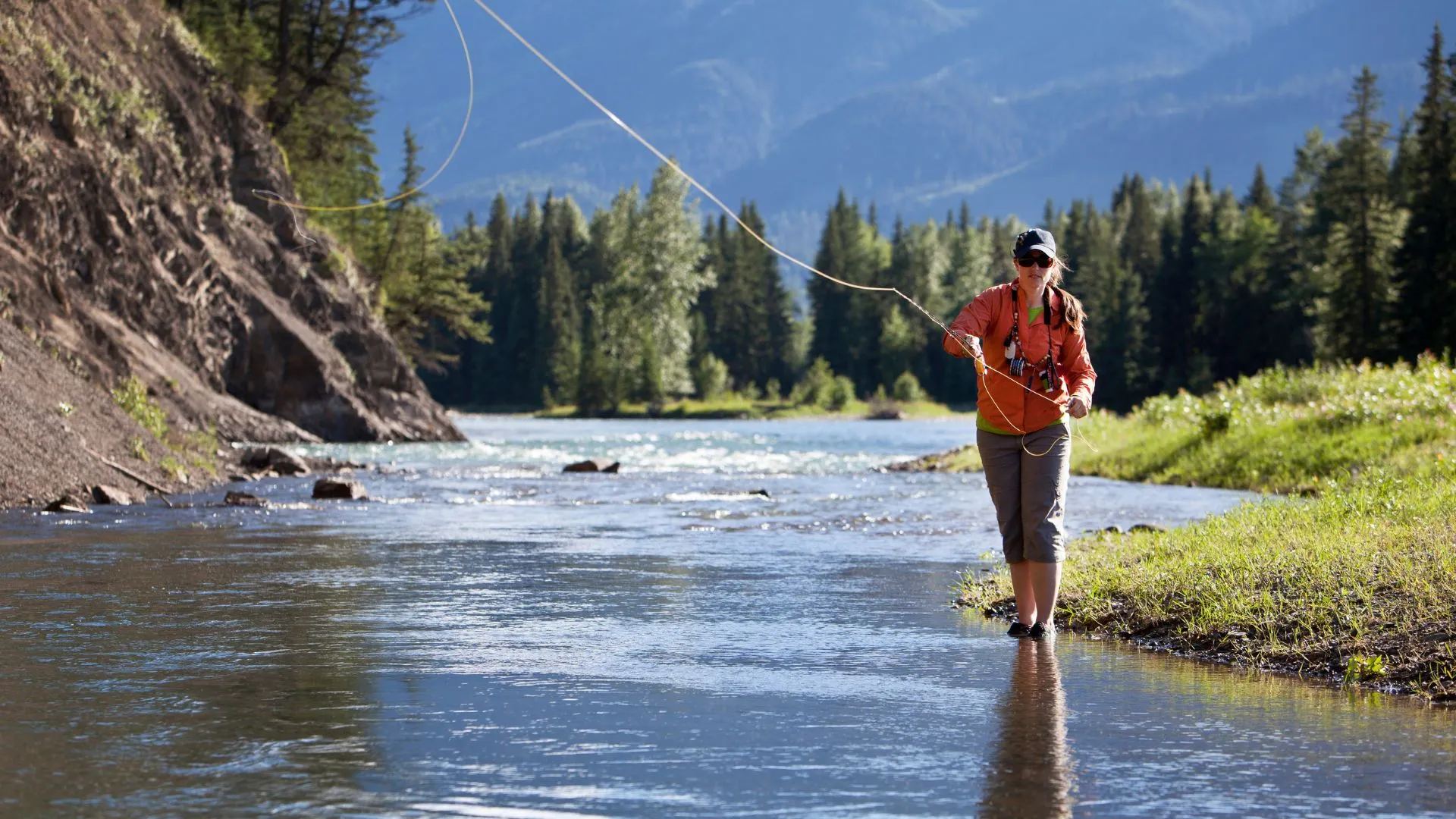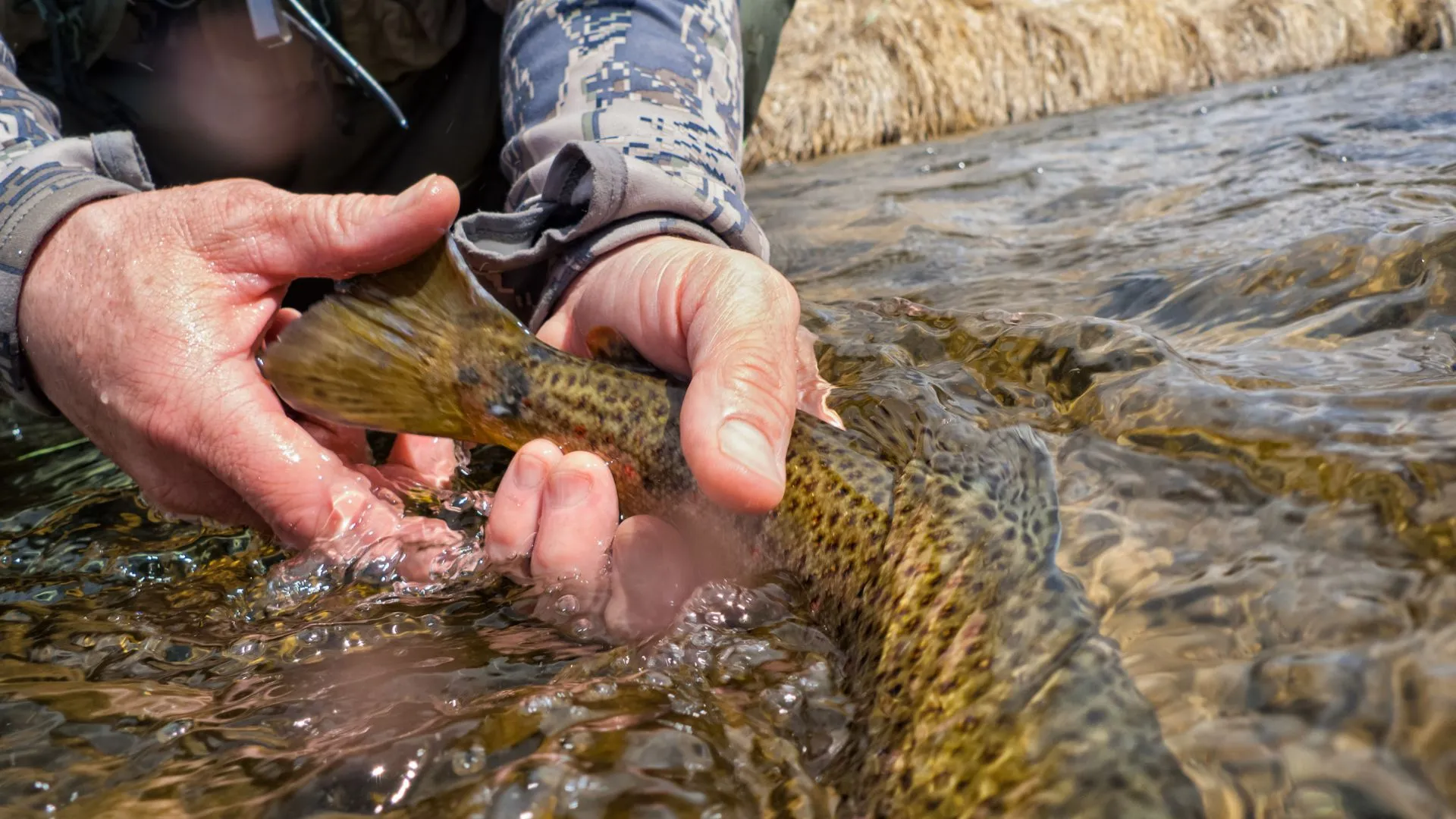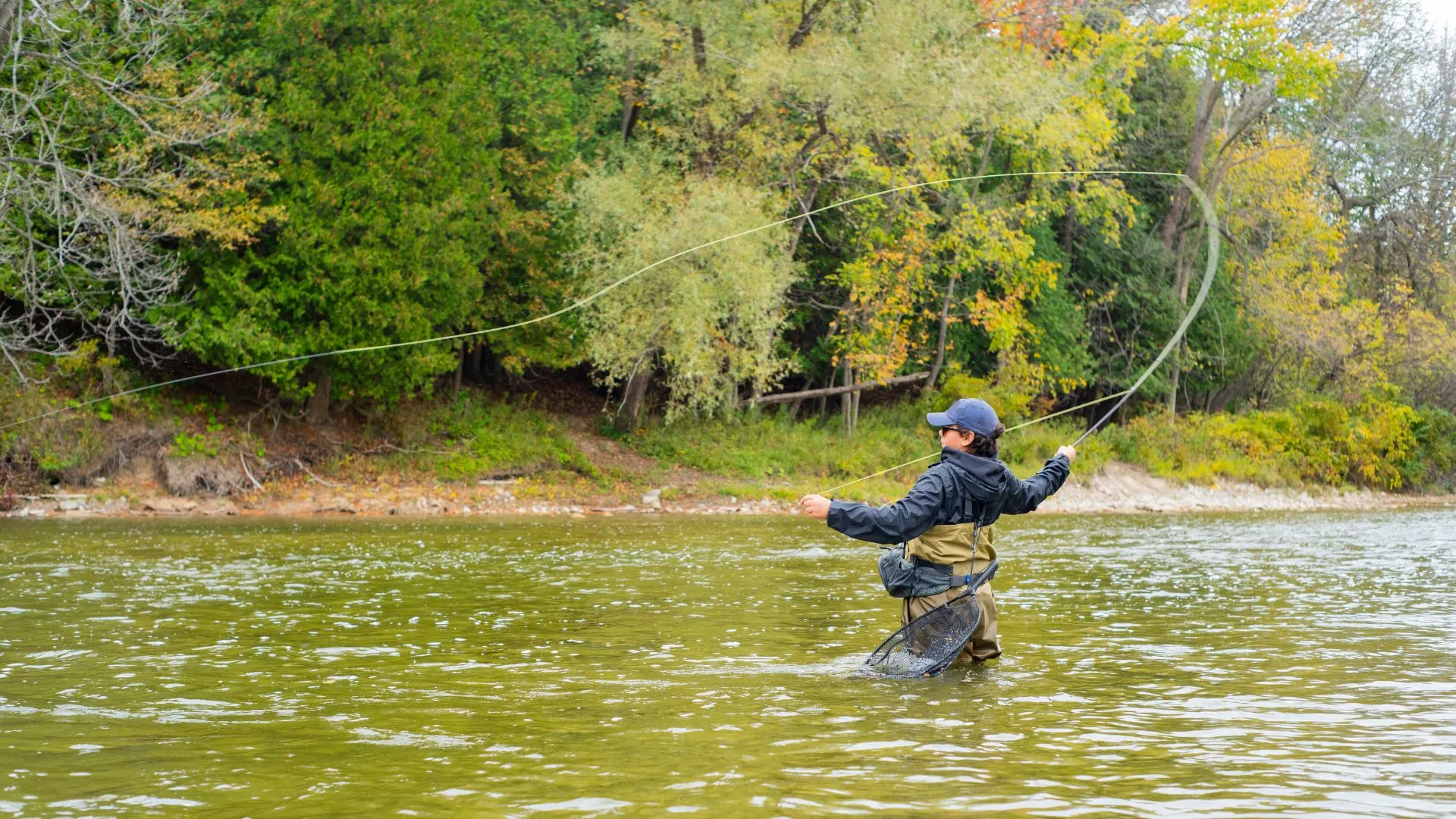Looking for a fly fishing experience that’s out of the ordinary? Look no further than driftless fly fishing in the heart of the Midwest.
Similar to fishing the Bois Brule River, the Driftless region offers a one-of-a-kind adventure for anglers, with its unique combination of pristine streams, breathtaking landscapes, and an abundance of trout species.
So grab your gear and get ready for an unforgettable journey into driftless fly fishing paradise. Get lost in nature’s beauty while connecting with centuries-old traditions. This is more than just fishing; it’s an escape into serenity and excitement all at once.

Best spots for fly fishing in the Driftless region
The Driftless region is a haven for fly fishing enthusiasts, offering a variety of scenic locations and abundant trout streams. Whether you’re a seasoned angler or just starting out, there are several spots in this picturesque area that promise an unforgettable experience.

Renowned trout streams like the West Fork of the Kickapoo River
One of the top destinations for fly fishing in the Driftless region is the West Fork of the Kickapoo River. This renowned trout stream meanders through valleys and hills, providing anglers with ample opportunities to test their skills.
The river’s crystal-clear waters are home to brown and brook trout, making it a prime location for catching these prized fish. With its diverse pools, riffles, and runs, the West Fork offers a challenging yet rewarding experience for fly fishermen.
Hidden gems such as Timber Coulee Creek and Coon Creek
While the West Fork may be well-known among anglers, there are hidden gems in the Driftless region that offer equally satisfying fishing experiences.
Timber Coulee Creek is one such gem, boasting excellent populations of brown and brook trout. Its secluded nature adds to its allure, allowing anglers to immerse themselves in nature while casting their lines.
Another hidden treasure is Coon Creek, which winds its way through picturesque valleys and farmlands. This creek provides excellent opportunities for catching rainbow and brown trout. With its tranquil surroundings and peaceful ambiance, Coon Creek offers a serene escape from everyday life.
Diverse fishing opportunities at Blue River, Black Earth Creek, and more
In addition to renowned streams and hidden gems, the Driftless region boasts numerous other waterways that cater to all types of fly fishermen.
The Blue River presents an exciting challenge with its fast-flowing currents and deep pools where trophy-sized fish can be found. Anglers can test their skills against feisty brown trout and elusive brook trout in this scenic river.
Black Earth Creek is another popular destination, known for its excellent hatches and abundant trout population. This spring-fed creek offers a mix of challenging fishing conditions and rewarding catches, making it a favorite among fly fishermen.
Accessible public lands with ample fishing access points
One of the advantages of fly fishing in the Driftless region is the accessibility of public lands with numerous fishing access points.
These areas provide easy entry to rivers, streams, and creeks, ensuring that anglers can explore different spots without much hassle. Whether you prefer wading or casting from the bank, these public lands offer plenty of options to suit your fishing style.

Tips and Techniques for Successful Trout Fishing in the Driftless Area
Mastering nymphing techniques for catching elusive trout
Trout fishing in the Driftless area requires a solid understanding of nymphing techniques to increase your chances of success. Nymphs are aquatic insects in their juvenile stage, which make up a significant portion of a trout’s diet. To effectively imitate these underwater morsels, consider the following tips:
-
Choose the right flies: Opt for patterns that mimic the prevalent nymphs found in the trout streams of the Driftless area such as Pheasant Tails, Hare’s Ears, and Zebra Midges.
-
Use appropriate weight: Attach split shot or tungsten beadhead flies to get your nymphs down to the desired depth quickly.
-
Employ strike indicators: These small floating devices help detect subtle strikes by indicating any unusual movement or sudden stops.
Understanding hatch patterns to match flies effectively
Hatch patterns play a crucial role in successful trout fishing. By observing and understanding these hatches, you can select appropriate fly patterns that closely resemble what trout are actively feeding on. Consider these points:
-
Observe insect activity: Pay close attention to the water’s surface for signs of emerging insects such as mayflies, caddisflies, or stoneflies.
-
Match size and color: Select flies that mimic both the size and color of the insects being hatched. This attention to detail will significantly increase your chances of enticing strikes from hungry trout.
-
Experiment with different presentations: Vary your casting techniques and retrieve speeds until you find an approach that triggers a response from feeding fish.
Utilizing stealthy approaches to avoid spooking fish
In order not to scare off wary trout, it is essential to employ stealthy tactics when approaching trout water. Here are some strategies:
-
Stay low and out of sight: Crouch down and move slowly along the bank, keeping a low profile to avoid casting shadows on the water.
-
Wear neutral-colored clothing: Dress in earth tones that blend with your surroundings to minimize your visibility.
-
Make precise casts: Practice accurate casting to place your flies gently and accurately in the desired location without causing unnecessary disturbance.
Adapting to changing water conditions throughout the year
The Driftless area experiences varying water conditions throughout the year, which can impact trout behavior. To adapt successfully, consider these factors:
-
Water temperature: Trout are more active in cooler water, so focus on fishing early mornings or evenings during hot summer months.
-
Flow rate: Pay attention to changes in water flow caused by rainfall or dam releases as it affects where trout hold and feed.
-
Seasonal food sources: Adjust your fly selection based on the insects available during different seasons. Be aware of terrestrial insects like grasshoppers and ants during warmer months.
Trout fishing in the Driftless area requires patience, skill, and a willingness to adapt. By mastering nymphing techniques, understanding hatch patterns, utilizing stealthy approaches, and adapting to changing water conditions, you increase your chances of having a successful day on these pristine trout streams. So grab your gear and get ready for an unforgettable angling experience!

Choosing the right spinner for driftless trout fishing
Spinners can be a great option for trout anglers looking to switch up their techniques. Spin fishing offers a different experience from traditional fly fishing or tenkara angling, and selecting the right spinner is crucial for success in these unique waters.
Selecting spinners with natural colors that mimic local baitfish
Trout in the driftless region are known for their selective feeding habits, making it essential to present them with lures that closely resemble their natural prey. When selecting spinners, opt for those with natural colors that mimic local baitfish. Shades of silver, gold, brown, and olive are popular choices among anglers targeting trout in these waters.
Opting for smaller-sized spinners to target wary trout
Driftless trout are often cautious and easily spooked by larger lures. To increase your chances of enticing these wary fish, choose smaller-sized spinners. These compact lures not only appear more natural but also allow you to finesse your presentation in tight spots where larger offerings may be impractical.
Considering blade design and vibration patterns to attract fish
The blade on a spinner plays a vital role in attracting fish by creating flash and vibrations underwater. Different blade designs produce varying levels of vibration and movement, which can trigger strikes from curious or aggressive trout.
Experimenting with different blade styles such as Colorado blades or willowleaf blades can help you determine what works best on any given day.
Experimenting with different retrieves to find what works best
Once you have chosen the right spinner with appropriate coloration and blade design, it’s time to experiment with different retrieves. The way you retrieve your lure can make all the difference in enticing trout to strike.
Some days they may prefer a slow and steady retrieve, while on other occasions, a quick and erratic retrieve may be more effective. Don’t be afraid to mix it up until you find the retrieve that triggers the most strikes.
Essential Gear and Resources for Driftless Fly Fishing
Having the right gear and resources is essential for a successful outing. Whether you’re a seasoned angler or new to the sport, being well-prepared will greatly enhance your experience on the water. Here are some key items and resources that you’ll need to make the most of your driftless fly fishing adventure.
Quality Fly Rods Ranging from 3wt to 5wt for Delicate Presentations
One of the most important pieces of gear for driftless fly fishing is a high-quality fly rod. The delicate presentations required in this type of fishing call for rods with a lighter weight and more finesse.
Opting for rods ranging from 3wt to 5wt will provide you with the necessary sensitivity and control needed to effectively present your flies. These lighter rods allow for precise casting and delicate presentations, ensuring that your flies land softly on the water’s surface.
Lightweight Waders and Boots Suitable for Long Days on the Water
To fully enjoy driftless fly fishing, investing in comfortable waders and boots is crucial. Since you’ll be spending long hours standing in streams, lightweight waders are preferred to avoid discomfort or fatigue.
Look for breathable materials that offer both durability and flexibility. Choosing wading boots with good traction will provide stability as you navigate through various terrains while ensuring safety during your fishing excursions.

Assortment of Dry Flies, Nymphs, and Streamers Based on Local Insect Life
To entice trout in driftless streams, having an assortment of flies that mimic local insect life is essential. Researching the specific insects found in these waters will help you determine which patterns to include in your fly box.
Dry flies such as Adams, Elk Hair Caddis, or Blue Winged Olives work well when targeting rising trout on the surface. Nymph patterns like Pheasant Tails, Hare’s Ears, or Prince Nymphs are effective when fishing below the surface. Streamers like Woolly Buggers or Sculpzillas can be used to imitate baitfish and trigger aggressive strikes from larger trout.
Local Guidebooks, Maps, or Online Resources for Stream Information
Navigating driftless streams can be challenging without proper information. Utilize local guidebooks, maps, or online resources to gain insights into the specific streams you plan to fish.
These resources often provide valuable information such as access points, regulations, stream conditions, and recommended flies. Contacting local fly shops can offer firsthand knowledge and guidance from experienced anglers familiar with the area.
By equipping yourself with quality gear and utilizing available resources, you’ll be well-prepared for an enjoyable driftless fly fishing experience. Remember to support local fly shops as they can provide expert advice on gear selection and stream information. So grab your rod, put on your waders, pack your fly box with the right patterns, and get ready to explore the beautiful driftless region in pursuit of trout!
The Driftless area, spanning across parts of Wisconsin, Minnesota, and Iowa, is a paradise for fly fishing enthusiasts. While many anglers flock to popular rivers and lakes, there are numerous hidden gems waiting to be discovered in this unique region.
From secluded streams off-the-beaten-path to lesser-known tributaries teeming with wild trout, the Driftless area offers a wealth of opportunities for those seeking an unforgettable fishing adventure.
Discovering secluded streams off-the-beaten-path
One of the joys of exploring the Driftless region is stumbling upon secluded streams that are tucked away from the crowds. These hidden gems provide an escape from the hustle and bustle of more well-known fishing spots.
As you meander down winding gravel roads, you’ll find yourself surrounded by picturesque landscapes and pristine waters waiting to be explored.
Uncovering lesser-known tributaries teeming with wild trout
In addition to its larger rivers, the Driftless area is home to countless smaller tributaries that often go unnoticed by anglers. These lesser-known waterways can hold surprising numbers of wild trout, providing a thrilling challenge for even the most experienced fly fisherman.
With their crystal-clear waters and diverse insect life, these tributaries offer an authentic angling experience that is hard to replicate elsewhere.
Exploring small spring creeks tucked away in picturesque valleys
Nestled within the rolling hills and valleys of the Driftless area are small spring creeks that epitomize tranquility and natural beauty. These hidden treasures require some extra effort to reach but reward intrepid anglers with breathtaking scenery and exceptional fishing opportunities.
As you navigate through lush forests and babbling brooks, you’ll feel a sense of serenity that can only be found in these remote corners of the region.
Venturing into remote areas for a true wilderness fishing experience
For those seeking a true wilderness fishing experience, the Driftless area has plenty to offer. Remote sections of rivers and streams provide an escape from civilization, allowing anglers to immerse themselves in nature and disconnect from the outside world.
As you cast your line into these untouched waters, you’ll feel a sense of anticipation and excitement, knowing that you are venturing into uncharted territory.

Learning to read the water and identify trout-holding areas
One of the key skills anglers need to develop is the ability to read the water. This means understanding how various factors like current speed, depth, and structure influence where trout are likely to be found. By observing the flow patterns, riffles, pools, and undercut banks, anglers can identify potential trout-holding areas.
To improve your ability to read the water, take note of where you consistently find fish during each outing. Look for features such as submerged rocks or fallen trees that create pockets of slower-moving water where trout can rest and feed. Pay attention to changes in current speed as this often indicates transitions between different types of habitat preferred by fish.
Utilizing topographic maps to locate access points and parking areas
Accessing prime fishing locations in the driftless region requires careful planning and knowledge of stream access points. Topographic maps can be invaluable tools for identifying potential entry points along streams. These maps provide detailed information about elevation changes, which can help anglers determine suitable parking areas near their desired fishing spots.
When studying a topographic map, look for roads or trails that intersect with streams you wish to explore. These intersections often indicate accessible entry points where you can park your vehicle or start hiking towards your fishing destination. By using these maps effectively, you can save time and effort by choosing the most convenient access point.
Practicing proper stream etiquette when encountering other anglers
In popular fly fishing destinations like the driftless region, it’s common to encounter other anglers on the streams. Practicing good stream etiquette is crucial for maintaining a positive experience for everyone involved.
Here are some guidelines for practicing proper stream etiquette:
-
Give other anglers plenty of space: When approaching another angler on a stream, avoid crowding their fishing spot. Respect their personal space and give them room to fish without interference.
-
Communicate and be friendly: If you encounter another angler, greet them with a friendly hello and engage in polite conversation. This helps foster a sense of camaraderie among fellow anglers.
-
Take turns: If you arrive at a particularly good stretch of water that is already occupied by another angler, wait your turn patiently. Rushing in or attempting to fish too close can disrupt the experience for both parties.
Being aware of private property boundaries and obtaining necessary permits
While there are many streams available for driftless fly fishing, it’s essential to respect private property boundaries and obtain any necessary permits before venturing onto private land.
To avoid trespassing on private property:
-
Research specific locations: Before heading out, research the streams you plan to fish and determine if they flow through private land. Websites, local fishing guides, or contacting local fishing organizations can provide current information on access points and potential restrictions.
-
Seek permission: If you come across a stream section that flows through private property but appears promising for fishing, try contacting the landowner beforehand to seek permission for access.
-
Obtain necessary permits: Some areas may require special permits or licenses beyond the standard fishing license. Check with local authorities or state agencies to ensure compliance with all regulations.

Reflecting on the experience of driftless fly fishing
In conclusion, driftless fly fishing offers an unparalleled angling experience in the heart of the Midwest. The Driftless region is teeming with prime spots for trout fishing, and armed with the right tips and techniques, you can have a successful outing every time. Choosing the appropriate spinner for driftless trout fishing is crucial to maximize your chances of reeling in that trophy catch.
Equipping yourself with essential gear and resources will ensure you are fully prepared for your driftless fly fishing adventure. Exploring hidden gems within the Driftless region allows you to discover new and exciting locations to cast your line. Navigating streams and accessing prime fishing spots can be a challenge, but it adds an element of thrill to your journey.
To make the most out of your driftless fly fishing experience, remember these key points:
-
Scout out the best spots: Research and explore different areas within the Driftless region known for their abundant trout populations.
-
Master the techniques: Hone your skills in trout fishing by learning effective casting methods, reading water conditions, and understanding trout behavior.
-
Choose wisely: Select spinners that mimic natural prey found in these waters to entice hungry trout.
-
Gear up: Invest in quality equipment such as rods, reels, waders, and flies tailored specifically for fly fishing in this unique region.
-
Seek adventure: Venture off-the-beaten-path to uncover lesser-known streams and secluded areas where fish thrive.
By following these guidelines, you’ll be well-equipped to embark on unforgettable driftless fly fishing expeditions time after time.
So what are you waiting for? Grab your gear, head out into nature’s playground, and immerse yourself in the thrill of driftless fly fishing today!
FAQs on Driftless Fly Fishing
What makes driftless fly fishing unique?
Driftless fly fishing stands out due to the region’s rugged terrain, cold-water streams, and abundant trout populations. The absence of glacial drift in this area has resulted in a distinct topography that provides exceptional angling opportunities.
Do I need special gear for driftless fly fishing?
While not necessarily “special,” having the right gear is crucial for a successful driftless fly fishing experience. This includes a fly rod and reel suitable for trout fishing, waders for stream access, appropriate flies or spinners, and other essential accessories like nippers and forceps.
Are there guided driftless fly fishing tours available?
Yes, there are various outfitters and guides who offer driftless fly fishing tours. Hiring a guide can provide valuable insights into the best spots, techniques, and local knowledge that will enhance your overall experience.
Can beginners try driftless fly fishing?
Absolutely! Driftless fly fishing caters to anglers of all skill levels. Whether you’re a seasoned pro or just starting out, this region offers ample opportunities to learn and improve your trout fishing skills.
What is the best time of year for driftless fly fishing?
The best time for driftless fly fishing depends on various factors such as weather conditions and hatches. Generally, spring through fall offers excellent angling opportunities, with May being particularly popular due to increased insect activity and hungry trout.
Are catch-and-release practices encouraged in the Driftless region?
Yes, catch-and-release practices are strongly encouraged in the Driftless region to preserve its thriving trout populations. By releasing fish unharmed back into the water, we contribute to sustainable angling practices that ensure future generations can enjoy this remarkable fishery.
Are there any regulations or permits required for driftless fly fishing?
Regulations and permit requirements may vary depending on specific areas within the Driftless region. It’s essential to familiarize yourself with local fishing regulations and obtain the necessary permits before embarking on your driftless fly fishing adventure.
